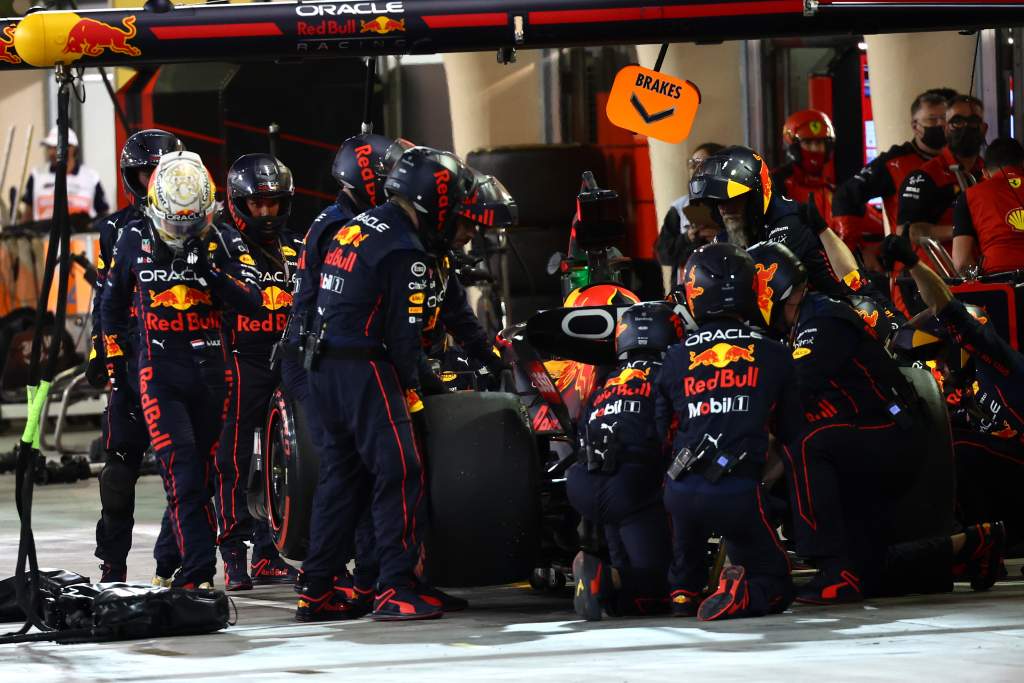Up Next

Red Bull’s disastrous double retirement in the closing stages of the Bahrain Grand Prix, which cost Max Verstappen second place and Sergio Perez fourth, has been blamed by Red Bull on a loss of fuel pressure despite there being sufficient fuel still in the tank.
So the question is, what exactly is the mechanism that caused this and why did Red Bull not realise the potential problem before the race? To understand how cars can be in a position not to have the fuel to continue despite there being enough left in the tank, we have to take a look in more detail at how the fuel system in an F1 car works.
Red Bull’s statement said: “Both cars suffered from a lack of fuel pressure last weekend. The correct amount of fuel was in both cars but a vacuum prevented the pumps from drawing fuel and delivering it to the engine.”

Fuel systems are fairly simple and actually very similar to those in today’s road cars. There is a big tank in the middle of the car that you put fuel in to suit the distance you are hoping to travel, and there is an outlet at the bottom that feeds the high-pressure pump. This supplies the fuel under pressure to the engine’s injectors, so it couldn’t be much simpler.
Within a typical F1 car’s fuel system, there will be some small-ish surge collectors, possibly one in each corner of the tank. As the car brakes or accelerates, turns left or right, these small, perhaps one-litre, reservoirs will fill up. Then, small low-pressure pumps will pump that fuel into a collector tank. This will be a tall collector, probably around two litres’ capacity.
At the top of that collector tank there will either be a small hole to vent the air out as the pumps fill that collector with fuel, or a small pressure-relief valve that blows off when the collector is under pressure from the low-pressure pumps filling the collector.
A small pressure-relief valve is my preferred route as it puts a small amount of pressure on the feed line to the high pressure pump increasing the boiling point of the fuel and in turn reducing the risk of cavitation when the high-pressure pump is requiring full flow.
To get the fuel out of the tank, you need to let air into the tank. At the very minimum, there should be a small valve on the fuel hatch that allows air into the tank to stop the high-pressure pump from creating a vacuum in the volume of the tank.
One way is to actually have the tank volume under a very small pressure. A simple feed from the airbox intake or a high-pressure area somewhere on the car will be enough to pressure the tank to remove any risk of a vacuum. It would need a one-way valve on this line to stop any fuel from spilling out if the car was inverted, but that’s not a big problem.
The hotter the fuel gets, the more risk of cavitation. This is the process whereby the fuel overheats and vapourises and prevents the high-pressure pump achieving the pressures required to operate the injectors.
So near the end of the race when the fuel is getting a bit low and there is very little volume left to dissipate that temperature, you need the collector pressure system to be working at its best. This wasn’t the case for Red Bull, which was likely not helped by the late safety-car period – which slowed the cars and reduced the overall cooling and therefore potentially increased the temperature of the fuel.
There’s no guarantee this is exactly the system Red Bull has and there are various problems that could cause this. But given it has said it was a vacuum that prevented the pumps drawing fuel, the problem does appear to be fuel cavitation. So this creates what’s also known as vapour lock, caused by the high temperature of a small amount of remaining fuel. Most likely, this was caused by the fact that the new E10 fuel does get a little hotter than the previous generation of fuel.

The big question is, why Red Bull didn’t anticipate this problem? This is exactly the scenario that pre-season testing is for. It’s likely that arriving on the last day with a completely new bodywork package probably disrupted its test programme, the consequence of which was it not completing a full race simulation that might have raised the problem.
Red Bull says it has now solved the problem. One way that could be done is carrying a little extra fuel, which comes with a weight penalty. Every 10kg of fuel is a time penalty of roughly 0.3s around a typical lap, so if you start with 10kg extra and use all of it, that’s an average of 5kg extra over the race distance at a cost of 0.15s per lap. So over a 57-lap race like Bahrain that will cost you 8.5s compared to the ideal fuel level.
So it wasn’t that Red Bull made a fuelling error, but it did fail to anticipate a potential problem in the fuelling system. As they say, to finish first, first you have to finish. So Red Bull will probably put that little bit extra in the tank in Saudi Arabia. I know I would. But the last few laps in Saudi will definitely be toe-tappers for Christian Horner!





